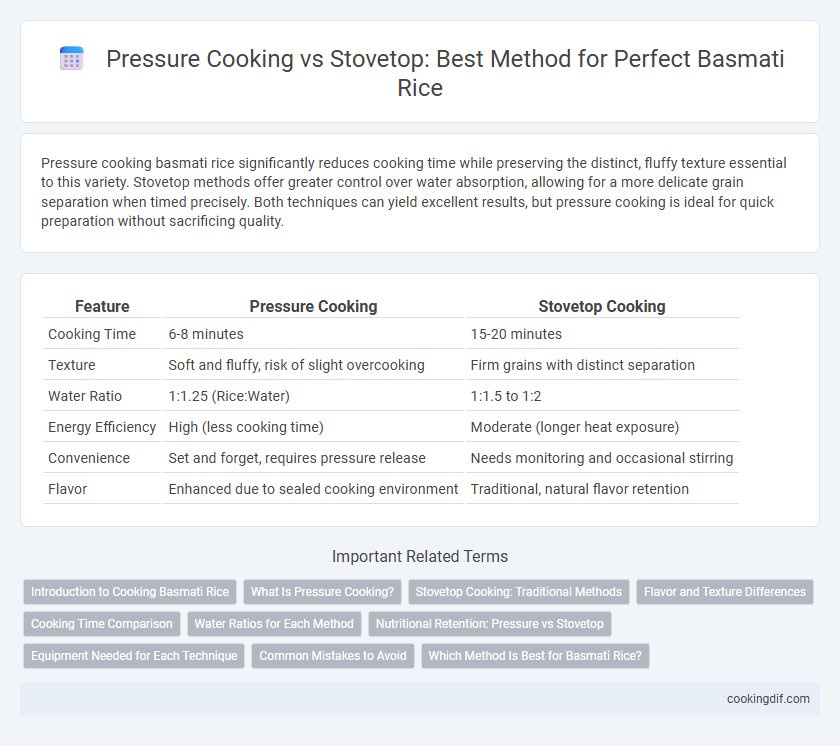Pressure cooking basmati rice significantly reduces cooking time while preserving the distinct, fluffy texture essential to this variety. Stovetop methods offer greater control over water absorption, allowing for a more delicate grain separation when timed precisely. Both techniques can yield excellent results, but pressure cooking is ideal for quick preparation without sacrificing quality.
Table of Comparison
| Feature | Pressure Cooking | Stovetop Cooking |
|---|---|---|
| Cooking Time | 6-8 minutes | 15-20 minutes |
| Texture | Soft and fluffy, risk of slight overcooking | Firm grains with distinct separation |
| Water Ratio | 1:1.25 (Rice:Water) | 1:1.5 to 1:2 |
| Energy Efficiency | High (less cooking time) | Moderate (longer heat exposure) |
| Convenience | Set and forget, requires pressure release | Needs monitoring and occasional stirring |
| Flavor | Enhanced due to sealed cooking environment | Traditional, natural flavor retention |
Introduction to Cooking Basmati Rice
Cooking basmati rice requires precise water-to-rice ratios and temperature control to achieve its characteristic fluffy texture and aromatic flavor. Pressure cooking shortens cooking time by using high steam pressure, preserving the rice's distinct grains and fragrance, while stovetop cooking demands careful timing and heat adjustment to prevent overcooking or sticking. Choosing between pressure cooking and stovetop methods depends on convenience and texture preference, with pressure cooking offering efficiency and stovetop allowing gradual control.
What Is Pressure Cooking?
Pressure cooking uses steam under high pressure to raise the boiling point of water, enabling faster and more efficient cooking of basmati rice compared to traditional stovetop methods. This technique traps steam inside a sealed pot, cooking rice quickly while preserving nutrients and enhancing flavor absorption. Pressure cooking basmati rice reduces cooking time significantly, typically requiring about 6-8 minutes under pressure versus 15-20 minutes on the stovetop.
Stovetop Cooking: Traditional Methods
Stovetop cooking preserves the authentic flavor and texture of basmati rice by allowing precise control over heat and water absorption throughout the cooking process. Traditional methods such as parboiling and simmering on low heat ensure fluffy, separate grains with optimal aroma retention. Mastery of stovetop timing and water ratios is essential to achieving perfect basmati rice without the risk of overcooking or mushiness common in pressure cooking.
Flavor and Texture Differences
Pressure cooking basmati rice results in a softer, more uniform texture with enhanced aromatic flavor due to steam infusion under high pressure. Stovetop cooking preserves individual grains' firmness and distinct texture, allowing subtle nutty flavors to develop through slower evaporation. Flavor intensity in pressure cooking is more concentrated, while stovetop methods provide greater textural contrast and traditional fragrance.
Cooking Time Comparison
Pressure cooking Basmati rice reduces cooking time significantly, typically taking around 5 to 7 minutes under high pressure, compared to stovetop methods that require 15 to 20 minutes of simmering. The sealed environment in pressure cookers traps steam, increasing temperature and speeding up the cooking process without overcooking the grains. Stovetop cooking demands more attention to prevent sticking or boiling over, prolonging overall preparation time.
Water Ratios for Each Method
Pressure cooking basmati rice requires a water-to-rice ratio of about 1.25:1 to prevent overcooking and achieve fluffy grains, compared to the stovetop method which typically uses a 2:1 ratio for absorption. The sealed environment in pressure cooking traps steam, reducing water evaporation and necessitating less water overall. Precise measurements are crucial as excess water in pressure cooking can result in mushy rice, whereas stovetop cooking allows more flexibility due to gradual water absorption.
Nutritional Retention: Pressure vs Stovetop
Pressure cooking basmati rice preserves more nutrients by reducing cooking time and minimizing nutrient loss from prolonged heat exposure, compared to stovetop methods. The sealed environment retains water-soluble vitamins like B-complex and minerals better than the open-pot stovetop boiling. Studies show pressure-cooked rice retains up to 20% more nutrients, making it a superior method for nutritional retention.
Equipment Needed for Each Technique
Pressure cooking basmati rice requires a pressure cooker or an electric pressure cooker, which maintains high steam pressure for faster cooking times and consistent texture. Stovetop preparation needs a heavy-bottomed pot or saucepan with a tight-fitting lid to ensure even heat distribution and prevent steam from escaping. Both methods benefit from measuring cups, a fine-mesh strainer for rinsing rice, and a timer to achieve optimal cooking results.
Common Mistakes to Avoid
Overcooking or undercooking basmati rice often results from incorrect water ratios in both pressure cooking and stovetop methods. Using excessive water in a pressure cooker can cause mushy texture, while insufficient water on a stovetop may lead to hard, unevenly cooked grains. Avoid lifting the lid prematurely during pressure cooking to prevent steam loss and ensure fluffy, separate basmati rice grains.
Which Method Is Best for Basmati Rice?
Pressure cooking basmati rice offers faster cooking times and retains more aroma due to the sealed environment that traps steam and flavors. Stovetop cooking provides greater control over texture, allowing for fluffy, separate grains when using proper water ratios and heat management. For optimal basmati rice, stovetop remains favored by chefs seeking precise texture, while pressure cooking suits those prioritizing speed and convenience without significant loss of quality.
Pressure cooking vs stovetop for basmati Infographic

 cookingdif.com
cookingdif.com